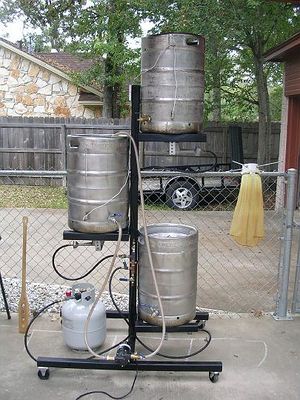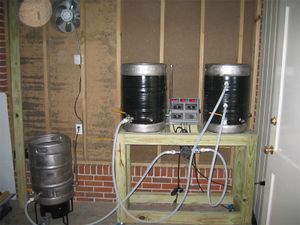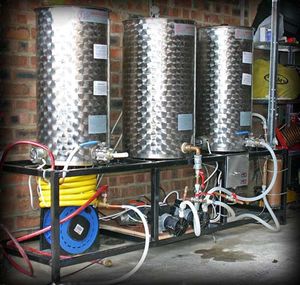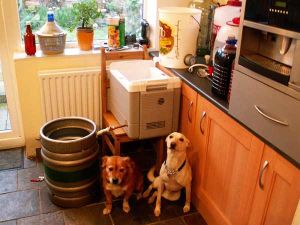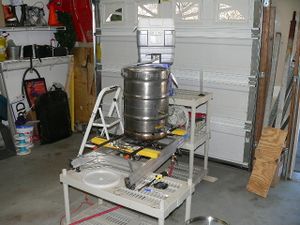| Line 7: | Line 7: | ||
There are several designs that can be employed and they will vary based on how you prefer to brew and how much complexity you can live with. There are a few common themes regardless of the design. | There are several designs that can be employed and they will vary based on how you prefer to brew and how much complexity you can live with. There are a few common themes regardless of the design. | ||
| − | Burners for direct fired vessels are usually mounted/fixed to the sculpture where they will be used. The gas feeding those burners is usually plumbed off a manifold with control valves for each burner unless each burner is fed by its own propane tank. | + | Burners for direct fired vessels are usually mounted/fixed to the sculpture where they will be used. The gas feeding those burners is usually plumbed off a [[manifold]] with control valves for each burner unless each burner is fed by its own propane tank. |
There are two main philosophies on liquid management; Hard plumbed and quick disconnects. A hard plumbed system links all the vessels with copper, stainless or flex tubing and the flow is controlled with a series of valves without disconnecting anything. In a quick disconnect system, a pair of hoses are interchanged between vessels to transfer liquids at varying stages of the brewing process. This saves money on valves and simplifies the system overall, but requires more brewer involvement. | There are two main philosophies on liquid management; Hard plumbed and quick disconnects. A hard plumbed system links all the vessels with copper, stainless or flex tubing and the flow is controlled with a series of valves without disconnecting anything. In a quick disconnect system, a pair of hoses are interchanged between vessels to transfer liquids at varying stages of the brewing process. This saves money on valves and simplifies the system overall, but requires more brewer involvement. | ||
Revision as of 03:29, 8 December 2008
A brew sculpture is a structure that holds the various vessels (Hot Liquor Tank, Mash/Lauter Tun, and Boil Kettle) used in all grain brewing. One of the major advantages to using a sculpture is that it normalizes the brewing process allowing for a smoother brew day and reducing setup and tear down time. Vessel to vessel connections can be made somewhat permanently and optional devices like pumps and chillers can be mounted as well. Most sculptures are made as compact as possible and feature castors/wheels to tuck it out of the way between brew sessions. The variance of design is limited only by the brewer's imagination, budget, and fabrication skills.
Contents
Sculpture Designs
There are several designs that can be employed and they will vary based on how you prefer to brew and how much complexity you can live with. There are a few common themes regardless of the design.
Burners for direct fired vessels are usually mounted/fixed to the sculpture where they will be used. The gas feeding those burners is usually plumbed off a manifold with control valves for each burner unless each burner is fed by its own propane tank.
There are two main philosophies on liquid management; Hard plumbed and quick disconnects. A hard plumbed system links all the vessels with copper, stainless or flex tubing and the flow is controlled with a series of valves without disconnecting anything. In a quick disconnect system, a pair of hoses are interchanged between vessels to transfer liquids at varying stages of the brewing process. This saves money on valves and simplifies the system overall, but requires more brewer involvement.
The most common raw material used for sculptures is steel for its strength and resistance to heat. Both angle and square/rectangular profiles are used and are either welded and/or bolted together. Some designs use wood but have the potential disadvantage of weight/bulk and flamability.
Three Tier
The 3-tier sculpture, as you can imagine, holds each of the three all grain vessels at different heights. The height between vessels is to allow gravity to drain the liquids. The top vessel is the Hot Liquor Tank (HLT), the middle vessel is the Mash/Lauter Tun (MLT), and the lowest is the Boil Kettle (BK). The HLT is mounted at the top so water can drain down into the MLT for infusions and sparging. The BK is mounted at the bottom, below the MLT, so that the wort can be drained during sparging. The boil kettle is sometimes mounted high enough that it too can be gravity drained into the fermenter sitting on the floor/ground.
The two prevailent designs are step-like and center pole. Step-like is self explanatory in that all vessels are mounted in a straight line, each higher than the previous. A center pole design (and some variants), like the one in the picture, uses a smaller footprint by mounting the HLT above the BK.
Pros:
- Inexpensive
- No pumping required (can be used in remote locations devoid of electrical power).
Cons:
- Height (add up the height of your fermenter, BK, MLT, and HLT and that is how tall your ceiling must be.
- Step ladder required for mash stirring.
- Recirculating mash sytems still require a pump.
Note: This design can be used for both batch or fly sparging without any changes.
Two Tier
The two-tier sytem moves the intermediate level of the MLT either up to the same level as the HLT or down to the same height as the the BK. It allows for one of the liquid transfers to remain gravity based while the other requires a pump or other manual means of transfer. This seems to be a relatively uncommon setup and is usually a way for a fly sparger to avoid buying two pumps up front.
Pros:
- Not as tall as a 3 tier system.
- Easier to stir mash if the MLT is on the BK level.
Cons:
- Still requires a pump or manual transfer.
One Tier
A single tier sculpture is one that holds all three of the all grain brewing vessels at the same height. Liquids must either be pumped between the vessels or otherwise manually transfered by hand (presumably by draining into a bucket or pot and dumping it into the adjacent vessel). Of course, the use of pump(s) accentuates the hands-off purpose of a sculpture in the first place.
Pros:
- Height. (Doughing in and stirring the mash will not require a step ladder).
- Safety (no vessels full of hot liquid over the brewer's head.)
Cons:
- Cost
- Pump or Pumps required.
- Size (Larger footprint)
Note: A single pump is required for batch sparging while two pumps will be required for fly sparging. In a fly sparge process, clean water must be pumped from the HLT into the MLT while sweet wort is pumped out of the MLT into the BK. Batch sparging only requires liquid transfer from one vessel at a time, in bulk.
Hybrid/redneck/Ghetto
While the main advantage of fixed sculptures has been discussed, many brewers do not have the space to accomodate a dedicated structure/system. Since brewing beer is the main focus, we must make due with what we have available. Some folks will utilize household items or built-in architectural features to mount their brewing vessels. Some common objects include:
- Countertops and household appliances.
- Multi-tier decks/porches.
- Ladders/Scaffolding
- Plastic utility shelving.
- Pickup trucks
- etc.
Home made
|
This section is a stub.
|
Commercial
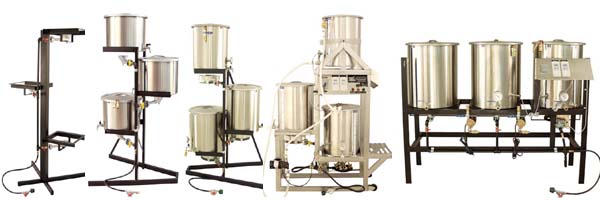
|
This section is a stub.
|

